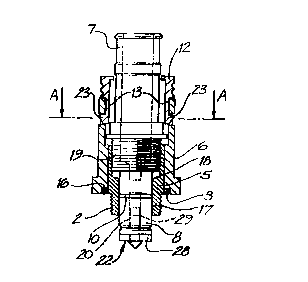Some of the information on this Web page has been provided by external sources. The Government of Canada is not responsible for the accuracy, reliability or currency of the information supplied by external sources. Users wishing to rely upon this information should consult directly with the source of the information. Content provided by external sources is not subject to official languages, privacy and accessibility requirements.
Any discrepancies in the text and image of the Claims and Abstract are due to differing posting times. Text of the Claims and Abstract are posted:
| (12) Patent Application: | (11) CA 2265627 |
|---|---|
| (54) English Title: | A RISING STEM TAP OF PLASTIC, PREFERABLY WITH A METAL THREADED INSERT |
| (54) French Title: | ROBINET A TIGE MONTANTE DE PLASTIQUE, DE PREFERENCE A INSERT METALLIQUE FILETE |
| Status: | Deemed Abandoned and Beyond the Period of Reinstatement - Pending Response to Notice of Disregarded Communication |
| (51) International Patent Classification (IPC): |
|
|---|---|
| (72) Inventors : |
|
| (73) Owners : |
|
| (71) Applicants : |
|
| (74) Agent: | AVENTUM IP LAW LLP |
| (74) Associate agent: | |
| (45) Issued: | |
| (86) PCT Filing Date: | 1997-09-19 |
| (87) Open to Public Inspection: | 1998-03-26 |
| Availability of licence: | N/A |
| Dedicated to the Public: | N/A |
| (25) Language of filing: | English |
| Patent Cooperation Treaty (PCT): | Yes |
|---|---|
| (86) PCT Filing Number: | PCT/AU1997/000620 |
| (87) International Publication Number: | WO 1998012460 |
| (85) National Entry: | 1999-03-08 |
| (30) Application Priority Data: | |||||||||
|---|---|---|---|---|---|---|---|---|---|
|
A tap body (1) comprising a plastic shroud (6), a
substantially plastics tap spindle (7), and a locking collar (12).
The body (1) has an inner threaded metal portion (18) and
the spindle (7) is threadably received in the inner threaded
portion (18) and rotatably reciprocable in tap opening and
closing directions. The collar (12) engages with the shroud
(6) to limit the tap opening rotation of the spindle (7). The
insert (18) may be plastic and integral with shroud (6): (see
fig. 6). Shroud (6) may be integral with tap seat, inlet and
outlet spigot (see figs. 7-9).
L'invention porte sur un corps (1) de robinet comportant une gaine plastique (6), une tige de manoeuvre (7) principalement en plastique, et un collier de fixation (12). Le corps (1) comporte une partie métallique (18) filetée intérieurement et la tige de manoeuvre (7) comporte un filetage s'engageant dans partie (18) filetée intérieurement et pouvant tourner soit dans le sens d'ouverture, soit dans le sens de la fermeture du robinet. Le collier (12) s'emboîte dans la gaine (6) de manière à limiter la rotation de la tige de manoeuvre (7) dans le sens de l'ouverture du robinet. La partie insérée (18) peut être de plastique et faire partie intégrante de la gaine (6) (figure 6). La gaine (6) peut faire partie intégrante du siège du robinet, ou des bouts unis d'entrée et de sortie (figures 7-9).
Note: Claims are shown in the official language in which they were submitted.
Note: Descriptions are shown in the official language in which they were submitted.

2024-08-01:As part of the Next Generation Patents (NGP) transition, the Canadian Patents Database (CPD) now contains a more detailed Event History, which replicates the Event Log of our new back-office solution.
Please note that "Inactive:" events refers to events no longer in use in our new back-office solution.
For a clearer understanding of the status of the application/patent presented on this page, the site Disclaimer , as well as the definitions for Patent , Event History , Maintenance Fee and Payment History should be consulted.
| Description | Date |
|---|---|
| Inactive: Adhoc Request Documented | 2018-06-06 |
| Appointment of Agent Requirements Determined Compliant | 2018-05-18 |
| Revocation of Agent Requirements Determined Compliant | 2018-05-18 |
| Inactive: IPC from MCD | 2006-03-12 |
| Application Not Reinstated by Deadline | 2002-09-19 |
| Time Limit for Reversal Expired | 2002-09-19 |
| Deemed Abandoned - Failure to Respond to Maintenance Fee Notice | 2001-09-19 |
| Inactive: Office letter | 2000-04-10 |
| Inactive: Correspondence - Transfer | 2000-02-21 |
| Letter Sent | 1999-06-01 |
| Inactive: Cover page published | 1999-05-19 |
| Inactive: IPC assigned | 1999-05-03 |
| Inactive: IPC assigned | 1999-05-03 |
| Inactive: First IPC assigned | 1999-05-03 |
| Inactive: IPC assigned | 1999-05-03 |
| Inactive: Single transfer | 1999-04-28 |
| Inactive: Courtesy letter - Evidence | 1999-04-27 |
| Inactive: Notice - National entry - No RFE | 1999-04-20 |
| Inactive: Applicant deleted | 1999-04-20 |
| Inactive: Applicant deleted | 1999-04-19 |
| Inactive: Applicant deleted | 1999-04-19 |
| Application Received - PCT | 1999-04-16 |
| Application Published (Open to Public Inspection) | 1998-03-26 |
| Abandonment Date | Reason | Reinstatement Date |
|---|---|---|
| 2001-09-19 |
The last payment was received on 2000-09-13
Note : If the full payment has not been received on or before the date indicated, a further fee may be required which may be one of the following
Please refer to the CIPO Patent Fees web page to see all current fee amounts.
| Fee Type | Anniversary Year | Due Date | Paid Date |
|---|---|---|---|
| Basic national fee - standard | 1999-03-08 | ||
| Registration of a document | 1999-04-28 | ||
| MF (application, 2nd anniv.) - standard | 02 | 1999-09-20 | 1999-08-23 |
| MF (application, 3rd anniv.) - standard | 03 | 2000-09-19 | 2000-09-13 |
Note: Records showing the ownership history in alphabetical order.
| Current Owners on Record |
|---|
| CAROMA INDUSTRIES LIMITED |
| Past Owners on Record |
|---|
| JOHN JOSEPH EAGLE |